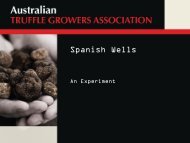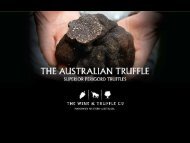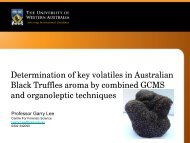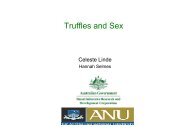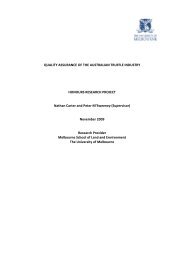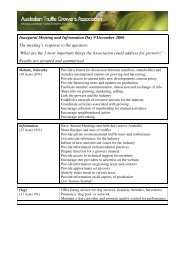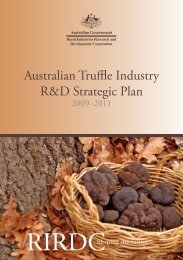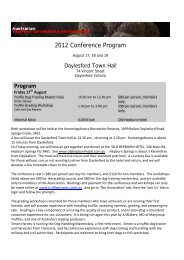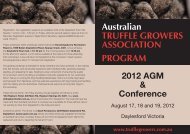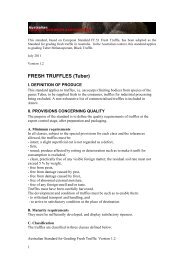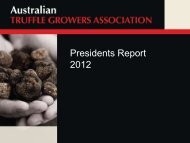President's Report - Australian Truffle Growers Association
President's Report - Australian Truffle Growers Association
President's Report - Australian Truffle Growers Association
Create successful ePaper yourself
Turn your PDF publications into a flip-book with our unique Google optimized e-Paper software.
The <strong>Australian</strong> <strong>Truffle</strong> <strong>Growers</strong> <strong>Association</strong><br />
PRESIDENTS REPORT<br />
Annual General Meeting and Information Day, 25 July, 2009.<br />
It is a great pleasure to welcome you all here to the third Annual General Meeting and Information<br />
Day of the <strong>Australian</strong> <strong>Truffle</strong> <strong>Growers</strong> <strong>Association</strong>. I hope you will find the meeting of value and I<br />
would encourage you to contribute to the working of the <strong>Association</strong> for the improvement of the<br />
industry in any way you feel you are able.<br />
1. The Second AGM and Information Day and Activities since last year.<br />
The second Annual General Meeting and Information Day and Dinner was held on the 27th of July<br />
2008 at Pakenham in Victoria and was well attended by members interested parties. Sunday 28 July<br />
comprised a workshop to discuss issues for growers and a visit to a local truffiere. The <strong>Association</strong><br />
will continue to take the AGM and Information day around the country to developed and<br />
developing growing areas, so that all members can benefit from the shared experience of growers.<br />
The meetings, being open to the public, also provide a good opportunity for us the better educate<br />
interested people about our industry and product.<br />
I think we can be very proud of our achievements over the past 2 and a half years of the<br />
<strong>Association</strong>s’ existence and the highlights are shown on the screen. A major activity for the<br />
<strong>Association</strong> during the year was the continuation of a sound working relationship with the RIRDC<br />
and it is a pleasure to welcome the Managing Director, Dr Peter O’Brien, here today. We have<br />
been working closely with the RIRDC Senior Research Manager - New Plant Products, Alan<br />
Davey, and his staff. They have been particularly helpful in sharing their experience and that of<br />
other new industries, and in directing us towards informed and useful contacts. They have also<br />
been generous in supporting us again with this, our third, AGM and Information day.<br />
Achievements include the development of a draft truffle grading standard for the industry, liaison<br />
with AQIS on the ban on the import of potentially damaging truffles, the development of a draft<br />
strategic development plan, the launch of our first two R&D projects and the formation of an<br />
industry steering group. The last three have been with the invaluable assistance of RIRDC.<br />
I will talk about these activities later in the report.<br />
2. Website.<br />
The website continues with very low input resources but I hope you will agree that it is informative<br />
and useful. We have further plans for its development and would welcome any suggestions for<br />
further improvement. We have also instituted the bulletin email mailing lists idea to keep members<br />
informed of new postings and provide that as ‘value added’ for members."<br />
We have feedback about the difficulties of the forums being overly complicated and confusing and<br />
they have been the target of SPAM attacks. This is difficult to manage and is unrewarding, as it is<br />
not being used. We have removed the members-only restriction on the forums but visitors still need<br />
to register so we can avoid the otherwise inevitable deluge of spam posts to the site. We propose<br />
one of two options, first to close the forums altogether, or second to change the forums to a different<br />
package, which is simpler to use and has better SPAM protection in. If we choose the second, we<br />
need funding or someone to volunteer as a moderator for the forums, to keep it working.<br />
1
We have also set up wiki on the website, using exactly the same software as wikipedia, to be used<br />
to store growers information in the hope of producing a growers manual, as well as to host<br />
frequently asked questions. Members are encouraged to create an account, log-in and contribute<br />
as much information and some members have already volunteered to prepare information.<br />
Some basic info regarding the website is that we have had just under 11,000 visitors to the site in<br />
the past year with the average time spent on the site by each visitor just over 4 minutes and viewing<br />
3 pages each. Of the visitors, 80% are from Australia, with others from America, NZ and the UK in<br />
that order.<br />
3. <strong>Truffle</strong> Festivals and other truffle events.<br />
Following the WA lead, a festival was initiated in Capital Country, an area from Bowral in the<br />
Southern Highlands of NSW, through Canberra, to the Snows of Mt Kosciusko. This was a private<br />
initiative and did not involve <strong>Association</strong> resources. The festival was launched on the Winter<br />
Solstice June 20 and will run for the harvest season.<br />
It has a number of local and regional restaurants using truffle as well as other simple events like<br />
hunts, grower forums and information about native truffles. The Festival has received wide support<br />
and will be an annual event. There are more than 30 growers in that area of NSW, including two<br />
growers in the ACT. We estimate that the truffle consumption in Canberra increased by 3 to 4<br />
times from 2008, reaching more than 4 kg per week in a town of 300,000 people.<br />
The WA growers are about to hold their third <strong>Truffle</strong> Festival at Mundaring during the first week of<br />
August and have held an event at Margaret River.<br />
We would urge other members in the other States to follow the Festival experience and establish<br />
similar events in the midst of the various truffle growing areas.<br />
4. Links with The NZ <strong>Truffle</strong> <strong>Association</strong><br />
Our <strong>Association</strong> Executive continues to maintain close links with the NZ <strong>Truffle</strong> <strong>Association</strong>, and it<br />
was my pleasure to spend last weekend attending their AGM in NZ. The NZTA held its AGM in<br />
Christchurch, on the South Island, 18 July this year and I was pleased to be able to represent the<br />
<strong>Australian</strong> <strong>Association</strong>. We are particularly pleased to have the NZTA President Jane Hunter, with<br />
us here today and Jane will talk to us later about the NZ <strong>Truffle</strong> industry and the direction of the<br />
NZTA. Also visiting us from NZ in Alan Hall and his partner Lynley. They are growers from<br />
Gisborne in NZ and Alan will talk to us tomorrow about his valuable experience in growing truffle<br />
and their nutrition requirements.<br />
One matter of mutual interest has been the agreement reached on a common draft truffle grading<br />
standard. The NZTA is very deserving of our thanks for the work they undertook to get that<br />
completed. Both countries share the same independent food standards statutory agency and it will<br />
be beneficial to have the same quality standard for grading, based largely on the European (and only<br />
existing) standard. Jane and I have discussed the possibility of collaborative research activities,<br />
including work on the genetic diversity.<br />
5. Where Are We Now<br />
The industry is represented by a number of different business models working in the industry from<br />
corporate investments, managed investments schemes, contract growers to small holders.<br />
The <strong>Association</strong> considers that the there are currently approximately 130 growers Australia wide,<br />
managing approximately 550 ha of plantation. This is slightly less than last years prediction but is<br />
2
considered more accurate. It is based on updated information from the RIRDC Industry Update<br />
<strong>Report</strong>. There are plantings in all states and territories, except the Northern Territory.<br />
The <strong>Association</strong> currently has 82 paid up members and about 15 of those are associates, either non<br />
growers, but in the industry as service providers or growers waiting to plant. We estimate that the<br />
current membership represents about 60% of the growers Australia wide and they manage<br />
approximately 300Ha or more than 120,000 trees, (at 400 trees/Ha). We estimate that the harvest in<br />
Australia in 2007 was about 800kg, and in 2008 was about 1200kg. This year we estimate that the<br />
harvest will be about 1.5 tonne. From the current areas planted we still have the potential to<br />
produce more than 5 tonne within 5 years, valued at up to $10 million.<br />
As I have been saying over the past two years, the rate of growth of production (and in new<br />
plantings) within the industry is a little frightening, but if we are to be on top of quality and develop<br />
a good industry marketing strategy for ‘<strong>Australian</strong>’ <strong>Truffle</strong>s, there is no reason to expect a<br />
significant drop in prices, when compared to international prices. We are producing an international<br />
product and should be able to maintain an international price.<br />
Our guest speakers today will talk about some of these issues in relation to our own and other<br />
industries.<br />
6. Working with the RIRDC.<br />
I cannot overemphasise the value of our engagement with RIRDC. The informative exchange of<br />
views on how we might progress the organisation as a truly Australia wide <strong>Association</strong> for all<br />
growers and how RIRDC might assist with ideas, research funding and referrals to the appropriate<br />
Government organisations for support is invaluable.<br />
RIRDC have emphasised that they have moved from being production driven to being market<br />
driven, (while still recognising the need for assistance with production). RIRDC assisted us with<br />
the preparation of the report, Taking Stock of the <strong>Australian</strong> <strong>Truffle</strong> Industry, presented at last years<br />
meeting by a representative of the RIRDC. We need to work to maintain the basics of that report so<br />
that we can adequately represent the industry to government with information on grower numbers,<br />
areas planted and production. I seek the cooperation of all of you in providing statistical<br />
information regarding the industry.<br />
RIRDC also assisted us with the funding of a strategic meeting in late 2008 involving industry<br />
representatives, particularly those representing the larger producers, who are not currently members<br />
of the <strong>Association</strong>. Ideas flowing from this meeting resulted in the preparation of a three year Draft<br />
Strategic Plan, with priorities, to allow the <strong>Association</strong> to work with consultants and growers on<br />
identifying research and development priorities. This document is available on the RIRDC website<br />
and will remain a living document, to be updated as required to meet the needs of the industry.<br />
As a result of this document we have now two R&D projects with RIRC support, addressing issues<br />
of truffle rot and the genetics of truffle stock in Australia. <strong>Truffle</strong> rot is a significant factor in yield<br />
and is being addressed with the help of the Wine and <strong>Truffle</strong> Co in WA. We have with us today<br />
Harry Eslick of the Wine and <strong>Truffle</strong> Company who is working closely with the RIRDC to facilitate<br />
the truffle rot survey. Low genetic diversity in truffles would limit their capability to form<br />
productive associations with tree species, genotypes and site interactions. The diversity will be<br />
compared to that in France to assess whether the <strong>Australian</strong> truffles may suffer from a genetic<br />
bottleneck impairing its ability to produce large truffle yields.<br />
The <strong>Association</strong> was also a participant of a meeting initiated by RIRDC, which included the<br />
principals of the Wine and <strong>Truffle</strong> Company of WA and the Périgord <strong>Truffle</strong> of Tasmania. While<br />
3
oth are currently independent of the <strong>Association</strong>, they are important stakeholders in the industry.<br />
The result of the meeting was an agreement to form a steering committee involving RIRDC, the<br />
<strong>Association</strong> and both organisations, which will strengthen the Industry and allow areas of common<br />
interest to be explored.<br />
This is a major achievement, as the Steering Group represents more than 95% of truffle production<br />
in Australia. This is the first step in moving towards a sound level of sustainable cooperation<br />
within the industry. An essential and important challenge for this group will be to suggest how the<br />
<strong>Association</strong> might be structured to meet the needs of all stakeholders and to enhance the ability of<br />
the <strong>Association</strong> to truly meet the needs of the industry. RIRDC have a media release covering this<br />
development.<br />
We are now able to confirm that AQIS has banned the import of all truffles with the exception of,<br />
T. melanosporum, magnatum, aestivum and borchii. We are working with the RIRDC to better<br />
understand how the ban is being enforced at entry points. NZ also has a similar ban on the import of<br />
truffles.<br />
We are also grateful for the RIRDC funding support to represent the <strong>Association</strong> at the NZTA<br />
AGM on 18th July, to continue our strong links with the NZ industry and also support for this AGM<br />
and information day, as I mentioned.<br />
7. Issues of quality, price and marketing.<br />
As I stated we estimate that the harvest will be about 1.5 tonne this year and the matter of quality<br />
has the potential to affect us all. We need to collectively develop a strategy on how we manage the<br />
supply chain and avoid the export of questionable product under the heading of '<strong>Australian</strong> <strong>Truffle</strong>s'<br />
as it has the potential of giving the '<strong>Australian</strong> <strong>Truffle</strong>' a bad name. There is no reason why we cant<br />
maintain the local and international price for truffles if we can maintain quality.<br />
We have taken the first small step in having a grading standard that is agreed between the<br />
<strong>Australian</strong> and NZ <strong>Association</strong>s, but this has yet to be adopted by the industry. Time and volume<br />
will solve the standards issue, as consumers will demand high quality products, irrespective of<br />
where they come from.<br />
Possible threats to prices also include larger growers undercutting the market through bulk supply<br />
offers and dumping of truffle on the market by small holders. This could be the result of desperate<br />
measures by smallholders to get rid of their crop due to a lack of knowledge or back up to market it<br />
properly. We have to address these issues through the <strong>Association</strong> and ensure that all producers<br />
appreciate these issues and their impact on both domestic and international markets.<br />
This leads us to the obvious need to address the problem of a shotgun approach to both the domestic<br />
and the international markets. One of our Guest Speakers today is from a relatively new and<br />
emerging industry, the Olive Oil industry in Australia, and the other from Australia’s largest<br />
producer of truffle, the Wine and <strong>Truffle</strong> Company of WA. I am sure that both will have some<br />
lessons that we will find useful in addressing our overall industry issues. I feel there would be great<br />
value in the <strong>Association</strong> undertaking some research into market drivers for truffle and better<br />
understanding market opportunities around the world and to promote ‘<strong>Australian</strong> <strong>Truffle</strong>s’.<br />
Domestically, the uptake of truffle by chefs during this harvest continues to be generally<br />
disappointing, although the knowledge about a truffle industry is rapidly increasing across<br />
Australia, due in large part to the activities of the <strong>Association</strong> and the festivals. The <strong>Association</strong><br />
has taken its AGM and information day to the various growing areas in support of growers and to<br />
raise the profile of the industry and has provided information to assist users in better understanding<br />
4
the product. It is a small step, but has generally been welcomed by end users. More funding is<br />
required for the promotion of truffles and the education of the end users and the general public.<br />
There is a significant uptake of truffle by the general public, estimated presently at about 25% of the<br />
harvest.<br />
The <strong>Association</strong> continues to make preliminary enquiries regarding information on truffle products<br />
and treatment to extend shelf life. These include flavour extraction, high pressure preservation and<br />
blast freezing.<br />
8. Future of the <strong>Association</strong> and Industry<br />
From work done by RIRDC (New Publication; Critical Success Factors for New Rural Industries),<br />
they have identified the following factors as essential for the success of new agricultural industries:<br />
• A primary focus on customers and marketing<br />
• A viable source of competitive advantage<br />
• Capability in quality control<br />
• A well functioning supply chain<br />
• Commercial and cutting edge research and development<br />
• Business proficiency and access to capital<br />
• Effective leadership and strategic planning across the industry<br />
An excellent publication and I can thoroughly recommend it to you all.<br />
If we are to progress and truly represent the industry, these are the issues that we must face;<br />
• Market: We need to establish a common product marketing approach for <strong>Australian</strong><br />
truffles and get a primary focus on customers and marketing both domestically and<br />
internationally.<br />
• Competitive Advantage: We have that already. We produce a high value product<br />
with an international price and have a competitive advantage with our off season<br />
supply to northern hemisphere and a closeness and understanding of Asia.<br />
• Price and Quality: We need to be able to sustain an international market selling price<br />
that adequately covers costs and produces a return on investment. Our reputation<br />
rests solely on quality, both domestically and internationally but we have yet to<br />
embrace a common grading standard on our home base. We also have to avoid price<br />
cutting.<br />
• Supply chain: We need to be able to lock in a closed-loop supply chain with links all<br />
the way through to the end user, the customer. We need to find common ground<br />
between the large and small producers if we are to address supply chain issues.<br />
• Cutting edge R&D: We need to be able to overcome the substantial challenges<br />
involved with producing satisfactory yields of a quality product at an acceptable cost<br />
and looking at product issues through R&D.<br />
• Industry <strong>Association</strong>: We need to be able to build a well-managed industry<br />
organisation that has credibility with government, represents the views of both<br />
individual and organisation members, has industry majority representation, achieves<br />
firm consensus, and performs according to a defined code of practice. It must have<br />
access to capital and be proficient at business. It must also make steady progress<br />
over time in all aspects of the business, through a process of continuous<br />
improvement.<br />
5
The current level of funding available to the <strong>Association</strong> is inadequate to meet the current costs of<br />
operation, contributions to R&D and promotion, and the expectations of members. The scale of the<br />
operation of the <strong>Association</strong> is such that consideration should be given to using a paid position to<br />
further the goals of the industry. There are essentially three types of participants in our industry,<br />
lifestyle farmers, commercial growers and investors. We need to decide what the <strong>Association</strong> is<br />
going to represent and I think it should represent all three, in the interest of management of quality<br />
and price.<br />
To achieve these goals and to be a worthy <strong>Association</strong>, we need to be able to present a commercial<br />
face, fund our operating costs and contribute to R&D in the identified fields at varying rates, from<br />
10% up to 50% or $-for-$. R&D includes work to improve production, packaging and products and<br />
the essential work on understanding market drivers for our product and the identification of<br />
marketing opportunities in Australia and around the world.<br />
If we are to achieve the above goals, we will need to increase <strong>Association</strong> fees and may need to<br />
consider the possibility of a levy on trees or production. There are many mechanisms we can<br />
investigate and I will not discuss them further here. There will be opportunity to discuss those this<br />
afternoon and following the presentations by our guest speakers. They will tell us of their<br />
experience in the evolutionary process towards becoming successful and sustainable on the<br />
international stage.<br />
Finally I wish to remind you that the position of President of the <strong>Association</strong> can only be held for a<br />
period of four years requiring a change at the next AGM. It is therefore important that we work to<br />
address the issues facing the <strong>Association</strong> quickly and seek the necessary continuity in leadership to<br />
further develop the industry.<br />
9. In Conclusion<br />
As mentioned, it is estimated that the Australia wide truffle harvest will be about 1.5 tonne this<br />
year, 2009. Most figures indicate that properly managed truffieres increase production by about<br />
40% to 60% each year which means it could double every two years. Conservatively, this means<br />
that the truffle harvest in 2014 could be in excess of 8 tonnes.<br />
The assistance by RIRDC to the <strong>Association</strong> in identifying the status of the industry in Australia<br />
and in facilitating the Industry Steering Group is a major step forward in finding sustainable<br />
solutions to industry issues. It is now up to us to identify specific goals and priorities for the<br />
<strong>Association</strong> to support the obvious rapid growth of the industry, in a way that benefits all. This will<br />
include education of consumers and providers in Australia and additional work on the identification<br />
of markets, both here and overseas, as well as cooperative R&D, to ensure all growers are able to<br />
move their product and be well rewarded.<br />
Your support and contribution to the <strong>Association</strong> is appreciated and will be needed in the future.<br />
We have a sound basis in the <strong>Association</strong> to develop a successful industry but we need more<br />
funding and we now need to look for the next wave of leaders in the Industry.<br />
Thank you for your attention.<br />
Wayne Haslam<br />
President<br />
The <strong>Australian</strong> <strong>Truffle</strong> <strong>Growers</strong> <strong>Association</strong>, Inc.<br />
25 July 2009<br />
6




